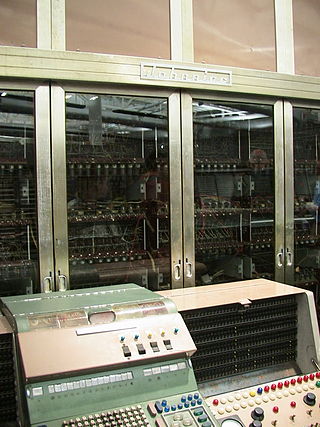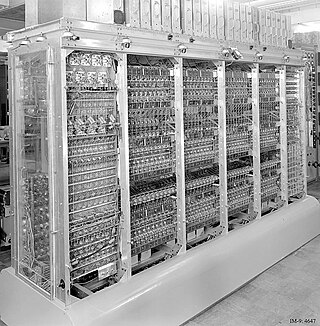Related Research Articles

Nokia Bell Labs, originally named Bell Telephone Laboratories (1925–1984), then AT&T Bell Laboratories (1984–1996) and Bell Labs Innovations (1996–2007), is an American industrial research and scientific development company owned by Finnish company Nokia. It is headquartered in Murray Hill, New Jersey, and operates a global network of laboratories.

Claude Elwood Shannon was an American mathematician, electrical engineer, computer scientist and cryptographer known as the "father of information theory". He was the first to describe the Boolean gates that are essential to all digital electronic circuits, and he built the first machine learning device, thus founding the field of artificial intelligence. He is credited alongside George Boole for laying the foundations of the Information Age.

The IBM 650 Magnetic Drum Data-Processing Machine is an early digital computer produced by IBM in the mid-1950s. It was the first mass produced computer in the world. Almost 2,000 systems were produced, the last in 1962, and it was the first computer to make a meaningful profit. The first one was installed in late 1954 and it was the most-popular computer of the 1950s.

The JOHNNIAC was an early computer built by the RAND Corporation and based on the von Neumann architecture that had been pioneered on the IAS machine. It was named in honor of von Neumann, short for John von NeumannNumerical Integrator and Automatic Computer.

The MANIAC I was an early computer built under the direction of Nicholas Metropolis at the Los Alamos Scientific Laboratory. It was based on the von Neumann architecture of the IAS, developed by John von Neumann. As with almost all computers of its era, it was a one-of-a-kind machine that could not exchange programs with other computers. Metropolis chose the name MANIAC in the hope of stopping the rash of silly acronyms for machine names, although von Neumann may have suggested the name to him.
The year 1940 in science and technology involved some significant events, listed below.

Robert Elliot Kahn is an American electrical engineer who, along with Vint Cerf, first proposed the Transmission Control Protocol (TCP) and the Internet Protocol (IP), the fundamental communication protocols at the heart of the Internet.
Excess-3, 3-excess or 10-excess-3 binary code, shifted binary or Stibitz code is a self-complementary binary-coded decimal (BCD) code and numeral system. It is a biased representation. Excess-3 code was used on some older computers as well as in cash registers and hand-held portable electronic calculators of the 1970s, among other uses.

George Robert Stibitz was an American researcher at Bell Labs who is internationally recognized as one of the fathers of the modern digital computer. He was known for his work in the 1930s and 1940s on the realization of Boolean logic digital circuits using electromechanical relays as the switching element.

The American Computer & Robotics Museum (ACRM), formerly known as the American Computer Museum, is a museum of the history of computing, communications, artificial intelligence and robotics that is located in Bozeman, Montana, United States.
Stuart K. Card is an American researcher and retired senior research fellow at Xerox PARC. He is considered to be one of the pioneers of applying human factors in human–computer interaction. With Jock D. Mackinlay, George G. Robertson and others he invented a number of information visualization techniques. He holds numerous patents in user interfaces and visual analysis.
Theory and Techniques for Design of Electronic Digital Computers was a course in the construction of electronic digital computers held at the University of Pennsylvania's Moore School of Electrical Engineering between July 8, 1946, and August 30, 1946, and was the first time any computer topics had ever been taught to an assemblage of people. The course disseminated the ideas developed for the EDVAC and initiated an explosion of computer construction activity in the United States and internationally, especially in the United Kingdom.
An accounting machine, or bookkeeping machine or recording-adder, was generally a calculator and printer combination tailored for a specific commercial activity such as billing, payroll, or ledger. Accounting machines were widespread from the early 1900s to 1980s, but were rendered obsolete by the availability of low-cost computers such as the IBM PC.
Raymond Paul "Raymie" Stata is an American computer engineer and business executive.

The PDP-8/e was a model of the PDP-8 line of minicomputers, designed by the Digital Equipment Corporation to be a general purpose computer that inexpensively met the needs of the average user while also being capable of modular expansion to meet the more specific needs of advanced user.

Sutherland's Volkswagen, or the Utah VW Bug, is a 3D model. It is a mathematical model of a 1967 Volkswagen Beetle and one of the earliest 3D computer models, aside from Catmull's hand.

The Model V was among the early electromechanical general purpose computers, designed by George Stibitz and built by Bell Telephone Laboratories, operational in 1946.
The PB 250 was a general-purpose computer introduced in 1960 by the Packard Bell Corporation.
References
- ↑ "Stibitz Model K Adder | 102627225 | Computer History Museum". www.computerhistory.org. Retrieved August 31, 2018.
- ↑ "George Robert Stibitz's Complex Number Calculator". Archived from the original on July 4, 2008. Retrieved September 29, 2017.
- ↑ ""Model K" Adder (replica) - CHM Revolution". www.computerhistory.org. Retrieved August 31, 2018.
- ↑ Irvine, M. M. (July 2001). "Early digital computers at Bell Telephone Laboratories" (pdf). IEEE Annals of the History of Computing. 23 (3): 22–42. doi:10.1109/85.948904. ISSN 1058-6180.